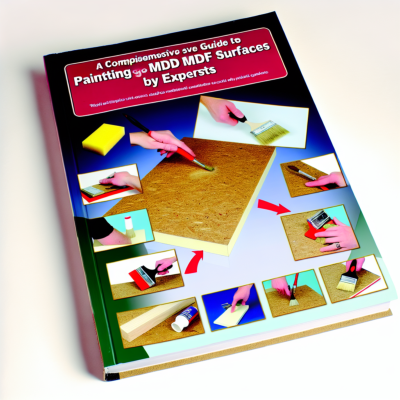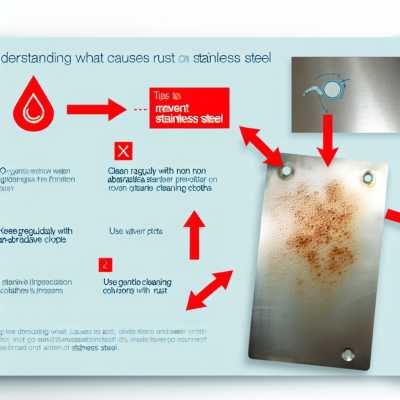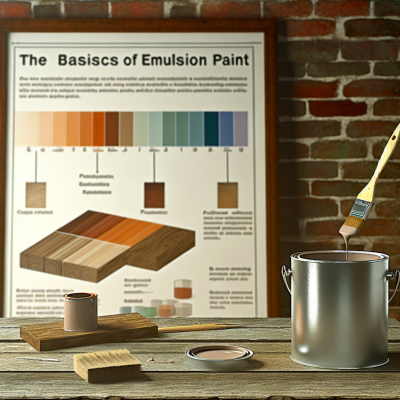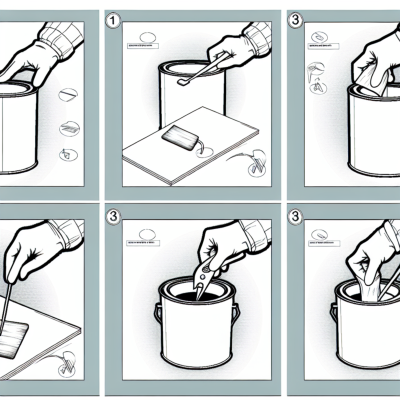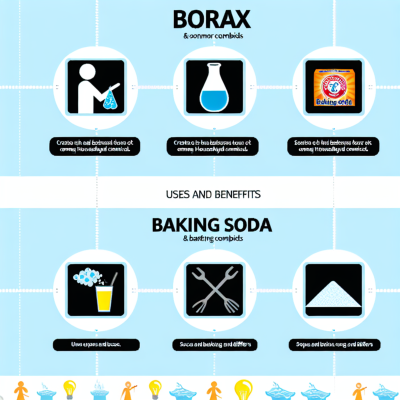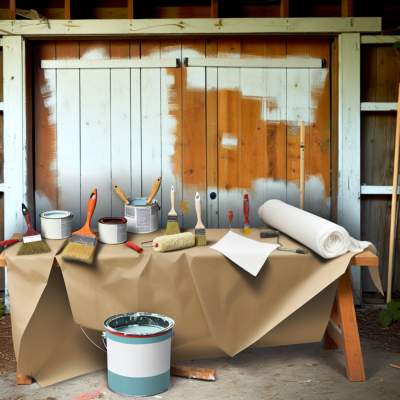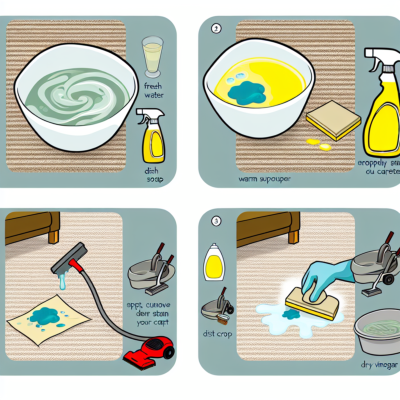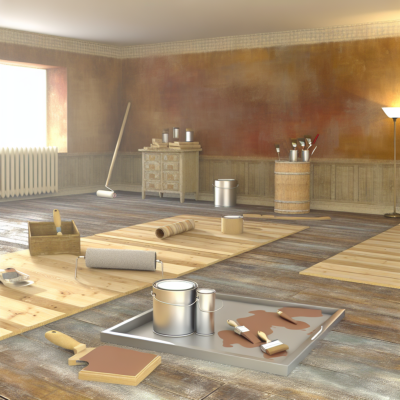When selecting paint for your walls, two common options are oil-based and water-based paints. Oil-based paints provide excellent durability and a smooth, luxurious finish. However, they have a strong odor and require mineral spirits for cleanup. On the other hand, water-based paints offer low odor, faster dry times, and easier soap and water cleanup. But they are generally less durable than oil-based options. When weighing oil-based vs water-based paint for your walls, consider factors like room traffic and moisture levels. This can help determine whether long-lasting oil-based or user-friendly water-based paint is the best choice for your particular walls and needs.
When it comes to painting your walls, choosing the right type of paint can make a big difference in the overall look and durability of your project. Two popular options to consider are oil-based paints and water-based paints. While both have their advantages and disadvantages, understanding the differences between the two can help you make an informed decision.
Oil-based paints have been around for a long time and are known for their durability and smooth finish. They are made with a petroleum or alkyd base, which gives them a strong odor and requires the use of solvents for cleanup. Oil-based paints are typically used for surfaces that require a tough and long-lasting finish, such as trim, doors, and cabinets. They are also great for covering stains and imperfections on the walls.
Water-based paints , on the other hand, have gained popularity in recent years due to their ease of use and environmental friendliness. They are made with a water base, which means they are easier to clean up with soap and water. Water-based paints have a milder odor compared to oil-based paints, making them a more pleasant option for indoor painting projects. They are commonly used for walls and ceilings, as they provide a smooth and even finish.
When deciding between oil-based and water-based paints for your walls, it is important to consider your specific needs and preferences. If you are looking for a durable and long-lasting finish, oil-based paints may be the better choice. However, if ease of use and environmental impact are your priorities, water-based paints are the way to go. Ultimately, the decision comes down to personal preference and the specific requirements of your project.
Understanding Oil-Based and Water-Based Paints
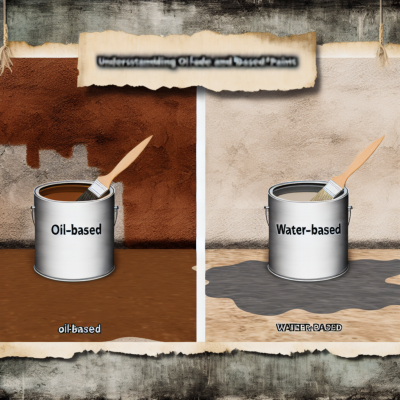
Painting your walls is a great way to refresh and transform your living space. When it comes to choosing the right paint, you have two main options: oil-based and water-based paints. Understanding the differences between these two types of paints can help you make an informed decision and achieve the desired results for your walls.
Oil-based paints , as the name suggests, are made with oil as the main solvent. They are known for their durability and ability to create a smooth, glossy finish. Oil-based paints are typically used for high-traffic areas and surfaces that need to withstand heavy wear and tear, such as trim, doors, and cabinets. They provide excellent adhesion and are resistant to moisture, making them suitable for use in bathrooms and kitchens.
While oil-based paints have their advantages, they also come with some drawbacks. They tend to have a strong odor and longer drying times, which can be a disadvantage if you need to complete your painting project quickly. Additionally, oil-based paints require mineral spirits for cleanup, which can be more challenging and time-consuming compared to water-based paints.
Water-based paints , also known as latex or acrylic paints, are made with water as the main solvent. They have become increasingly popular due to their ease of use and environmental friendliness. Water-based paints are quick-drying and have a low odor, making them ideal for interior painting projects. They are also easier to clean up, as they only require soap and water.
Water-based paints offer a wide range of finishes, including matte, eggshell, satin, and semi-gloss. They are suitable for most walls and surfaces, including drywall, plaster, and wood. However, they may not provide the same level of durability and smoothness as oil-based paints, which is why they are often not recommended for high-traffic areas or surfaces that are prone to moisture.
In conclusion, choosing between oil-based and water-based paints depends on your specific needs and the desired results for your walls. Consider factors such as durability, drying time, odor, and ease of cleanup before making a decision. If you are unsure, it is always a good idea to consult with a professional or seek advice from a paint specialist.
What is the difference between oil based and water based paints?
When it comes to choosing the right type of paint for your walls, one of the key decisions you'll need to make is whether to go with oil-based or water-based paint. Each type of paint has its own unique characteristics and advantages, so it's important to understand the differences before making your choice.
The Magnificent Waco Castle
| Oil-based Paint | Water-based Paint |
|---|---|
| Oil-based paint is made from a mixture of pigment and oil, typically linseed or alkyd oil. | Water-based paint is made from a mixture of pigment and water. |
| Oil-based paint takes longer to dry, often requiring several hours or even days before it is fully dry and ready for a second coat. | Water-based paint dries much faster, usually within an hour or two, allowing for quicker painting and shorter wait times between coats. |
| Oil-based paint has a strong odor and requires good ventilation during application. | Water-based paint has a milder odor and is generally considered to be more environmentally friendly. |
| Oil-based paint is known for its durability and resistance to wear and tear. | Water-based paint is less durable but can still provide good coverage and protection for interior walls. |
| Oil-based paint is often preferred for high-traffic areas such as hallways and kitchens. | Water-based paint is commonly used for interior walls in bedrooms, living rooms, and other low-traffic areas. |
Ultimately, the choice between oil-based and water-based paint will depend on your specific needs and preferences. Consider factors such as drying time, odor, durability, and the intended use of the painted surface when making your decision.
Which colour is best oil based or water based?
When it comes to choosing between oil-based and water-based paints, the decision often comes down to personal preference and the specific needs of your project. Both types of paint offer their own advantages and considerations, including the color options available.
Oil-based paints typically have a richer and more vibrant color compared to water-based paints. This is because oil-based paints contain pigments that are more concentrated, resulting in deeper and more intense hues. If you're looking for a bold and statement-making color, oil-based paints may be the better choice.
On the other hand, water-based paints offer a wide range of color options as well. They are available in various shades and tones, allowing you to find the perfect color for your walls. Water-based paints are also easier to tint, which means you can customize the color to your liking.
Additionally, water-based paints have the advantage of being low in VOCs (volatile organic compounds), making them a healthier and more environmentally friendly choice. They have less odor and release fewer harmful chemicals into the air during and after application.
In terms of durability, both oil-based and water-based paints can provide long-lasting results. However, oil-based paints tend to be more resistant to wear and tear, making them suitable for high-traffic areas. If you're painting a wall that will be subjected to frequent use and potential damage, oil-based paints may be the better option.
mould resistant paint
| Oil-based paints | Water-based paints |
|---|---|
| Richer and more vibrant colors | Wide range of color options |
| More resistant to wear and tear | Low in VOCs and environmentally friendly |
| May have stronger odor | Less odor and releases fewer harmful chemicals |
In conclusion, the best color option between oil-based and water-based paints ultimately depends on your personal preference and the specific characteristics you're looking for in a paint. Consider factors such as color intensity, customization options, health and environmental impact, and durability when making your decision.
Can you paint over oil-based paint without sanding?
If you have oil-based paint on your walls and want to switch to a water-based paint, you may be wondering if you can skip the sanding process. Sanding is typically recommended to create a rough surface that the new paint can adhere to. However, there are a few alternatives to sanding that you can try.
One option is to use a liquid deglosser or a chemical paint stripper. These products are designed to remove the gloss and smoothness from the surface of the oil-based paint, allowing the new paint to stick better. Simply apply the deglosser or paint stripper according to the manufacturer's instructions, and then wipe it off with a clean cloth.
Another option is to use a bonding primer. Bonding primers are specifically designed to adhere to glossy or difficult-to-paint surfaces, such as oil-based paint. Applying a bonding primer to the walls before painting can help the new paint adhere without the need for sanding.
It's important to note that while these alternatives can help you paint over oil-based paint without sanding, they may not be as effective as sanding in creating a long-lasting finish. Sanding provides the best surface for the new paint to bond to, so if you want the most durable and professional-looking results, it's still recommended to sand the walls before painting.
Before using any of these alternatives, it's a good idea to test them in a small, inconspicuous area to make sure they won't damage the paint or the wall surface. Additionally, always follow the manufacturer's instructions and take proper safety precautions when using chemical products.
Advantages and Applications of Oil-Based Paints

Oil-based paints have several advantages over water-based paints, making them a preferred choice for certain applications.
One of the main advantages of oil-based paints is their durability. These paints create a hard and durable finish that can withstand wear and tear, making them ideal for high-traffic areas such as hallways and staircases.
Oil-based paints also have excellent adhesion properties, allowing them to stick to a variety of surfaces including wood, metal, and concrete. This makes them suitable for a wide range of applications, from painting furniture to exterior surfaces.
Another advantage of oil-based paints is their ability to provide a smooth and glossy finish. These paints have a higher sheen level compared to water-based paints, giving walls and surfaces a luxurious and polished appearance.
In addition to their durability and smooth finish, oil-based paints are also resistant to moisture and stains. This makes them a great choice for areas that are prone to moisture, such as bathrooms and kitchens.
Despite their many advantages, oil-based paints do have some drawbacks. They have a strong odor and require proper ventilation during application. They also take longer to dry compared to water-based paints, which can prolong the painting process.
Overall, oil-based paints are well-suited for applications that require durability, adhesion, and a glossy finish. However, it is important to consider the specific needs of your project and weigh the advantages and disadvantages before choosing the type of paint to use.
What are the advantages of oil-based paint?
Durability: One of the major advantages of oil-based paint is its durability. It forms a hard and tough surface that can withstand wear and tear. This makes it ideal for high-traffic areas such as hallways and kitchens.
Smooth finish: Oil-based paint provides a smooth and glossy finish that gives a professional look to any surface. It can hide imperfections and provide a flawless appearance.
Stain resistance: Oil-based paint is resistant to stains and can be easily cleaned with soap and water. This makes it a great choice for areas that are prone to getting dirty or stained, such as bathrooms and kitchens.
Longer drying time: Unlike water-based paint, oil-based paint has a longer drying time. This can be beneficial as it allows for better leveling and reduces the visibility of brush strokes. It also gives you more time to work with the paint and make adjustments.
Good adhesion: Oil-based paint has excellent adhesion properties, meaning it sticks well to almost any surface. This makes it suitable for a wide range of materials such as wood, metal, and masonry.
Resistance to moisture: Oil-based paint is highly resistant to moisture and can withstand humidity and damp conditions. This makes it a suitable choice for areas with high moisture levels, such as bathrooms and basements.
Long-lasting color: Oil-based paint tends to retain its color for a longer period of time compared to water-based paint. It is less likely to fade or discolor over time, making it a more durable option for walls and other surfaces.
Versatility: Oil-based paint can be used both indoors and outdoors, making it a versatile option for various projects. It is suitable for walls, trim, furniture, and other surfaces.
Overall, oil-based paint offers a range of advantages including durability, smooth finish, stain resistance, good adhesion, resistance to moisture, long-lasting color, and versatility. However, it is important to note that oil-based paint has a strong odor and requires proper ventilation during application and drying.
What are the applications of oil-based paint?
Oil-based paint has a variety of applications due to its durability and ability to create a smooth, glossy finish. Some common applications of oil-based paint include:
- Interior and exterior wood surfaces: Oil-based paint is often used on wood surfaces such as trim, doors, and furniture. It provides a protective layer that helps prevent moisture damage and wear.
- Metal surfaces: Oil-based paint can be used on metal surfaces such as railings, fences, and appliances. It helps protect against rust and corrosion.
- Cabinets and kitchen fixtures: Oil-based paint is a popular choice for painting cabinets and kitchen fixtures due to its ability to withstand frequent cleaning and moisture exposure.
- High-traffic areas: Oil-based paint is commonly used in high-traffic areas such as hallways, staircases, and entryways. Its durability makes it resistant to scuffs and stains.
- Exterior surfaces: Oil-based paint is often used on exterior surfaces such as siding, shutters, and trim. It provides protection against weather elements and helps maintain the appearance of the building.
It's important to note that oil-based paint can have a strong odor and longer drying time compared to water-based paint. Additionally, proper ventilation and safety precautions should be followed when using oil-based paint due to its flammability.
things to do in summer
Overall, oil-based paint is a versatile option that can be used in various applications where durability and a smooth, glossy finish are desired. However, it's essential to consider the specific needs of the project and consult with a professional if necessary.
What are the disadvantages of oil-based paint?
While oil-based paint has its advantages, there are also several disadvantages to consider:
- Strong odor: Oil-based paint contains volatile organic compounds (VOCs) which result in a strong and lingering odor. This can be unpleasant for those with sensitivities or allergies.
- Longer drying time: Oil-based paint takes significantly longer to dry compared to water-based paint. It can take anywhere from 8 to 24 hours for oil-based paint to dry, depending on factors such as temperature and humidity.
- Difficult cleanup: Oil-based paint requires the use of harsh solvents such as mineral spirits or paint thinner for cleanup. These solvents can be toxic and require proper disposal.
- Yellowing and cracking: Over time, oil-based paint has a tendency to yellow and become brittle, leading to cracking or peeling. This can be particularly problematic in areas with high humidity or exposure to direct sunlight.
- Environmental impact: Oil-based paint is considered more harmful to the environment due to its higher VOC content and the need for solvents for cleanup. Water-based paint, on the other hand, has lower VOC levels and can be cleaned up with soap and water.
Considering these disadvantages, it is important to weigh the pros and cons before deciding to use oil-based paint for your walls.
Tips for Painting Over Different Paint Bases
When it comes to painting over different paint bases, there are a few key tips to keep in mind. Whether you are painting over oil-based paint or water-based paint, these tips will help ensure a smooth and professional-looking finish.
- Prepare the surface: Before painting over any paint base, it is important to properly prepare the surface. This may involve cleaning the walls, sanding any rough areas, and filling in any cracks or holes.
- Prime the surface: When painting over oil-based paint with a water-based paint, it is essential to first apply a coat of primer. This will help the new paint adhere properly and ensure a long-lasting finish.
- Choose the right paint: When painting over oil-based paint, it is important to use a high-quality water-based paint. Look for a paint that is specifically designed for use on oil-based surfaces.
- Use the proper tools: When painting over different paint bases, it is important to use the right tools for the job. This may include brushes, rollers, or sprayers that are specifically designed for the type of paint being used.
- Apply thin coats: When painting over any paint base, it is best to apply thin coats of paint. This will help prevent drips and ensure a smooth and even finish.
- Allow for proper drying time: After each coat of paint is applied, it is important to allow for proper drying time. This will help ensure that the paint fully adheres to the surface and prevents any smudging or smearing.
- Consider hiring a professional: If you are unsure about painting over different paint bases or want to ensure a professional finish, it may be worth considering hiring a professional painter. They will have the knowledge and experience to handle any challenges that may arise.
By following these tips, you can successfully paint over different paint bases and achieve a beautiful and long-lasting finish. Whether you are updating a room or repainting your entire home, these tips will help you achieve the desired results.
How do you paint over different layers of paint?
When it comes to painting over different layers of paint, there are a few important steps to follow to ensure a smooth and long-lasting finish.
1. Clean the surface: Before starting any painting project, it's important to clean the surface thoroughly. Use a mild detergent and water to remove any dirt, grease, or grime that may be present. Rinse the surface well and allow it to dry completely.
2. Sand the surface: If the existing paint is in good condition, you can lightly sand the surface to create a better bond for the new paint. Use a fine-grit sandpaper and sand in a circular motion. Be sure to wipe away any dust with a clean cloth before proceeding.
3. Repair any damage: If there are any cracks, holes, or other damage to the surface, it's important to repair them before painting. Use a suitable filler or patching compound, following the manufacturer's instructions. Allow the repairs to dry completely and sand them smooth if necessary.
4. Prime the surface: Applying a primer is especially important when painting over different layers of paint. It helps to create an even surface and improves the adhesion of the new paint. Choose a primer that is compatible with the type of paint you will be using and apply it according to the manufacturer's instructions.
5. Apply the new paint: Once the primer has dried, you can apply the new paint. Use a high-quality brush or roller for best results. Apply the paint in thin, even coats, allowing each coat to dry before applying the next. Follow the manufacturer's instructions for drying times and number of coats recommended.
Remember, it's always a good idea to test a small area before painting the entire surface, especially when working with different layers of paint. This will help ensure that the new paint adheres properly and provides the desired finish.
How do you cover up mismatched paint?
If you have a wall with mismatched paint, there are several options to consider for covering it up:
how to get sunscreen out of fabric
- Repainting the entire wall: If the mismatched paint is too noticeable or if you want a completely fresh look, repainting the entire wall is a good option. Choose a paint color that complements the rest of the room and make sure to properly prepare the surface before applying the new paint.
- Using a primer: Applying a primer can help create a neutral base for the new paint color. This is particularly useful if the mismatched paint is darker or significantly different from the desired color. Make sure to choose a primer suitable for the type of paint you plan to use.
- Color blocking: Another option is to embrace the mismatched paint and turn it into a design feature. You can create a color block effect by painting a different color or pattern over the mismatched area. This can add visual interest and make the mismatched paint look intentional.
- Adding an accent wall: If the mismatched paint is limited to one wall, you can create an accent wall to draw attention away from it. Choose a bold or contrasting color for the accent wall to make it a focal point in the room.
- Using wallpaper or wall decals: If you're not keen on repainting or if the mismatched paint is too difficult to cover, consider using wallpaper or wall decals to hide it. These options can add texture, pattern, and visual interest to the wall while covering up the mismatched paint.
Ultimately, the method you choose to cover up mismatched paint depends on your personal preference, the extent of the mismatch, and the overall design goals for the room.
When it comes to selecting wall paint, both oil-based and water-based options have their own sets of pros and cons to weigh. Oil-based paints deliver unparalleled durability, moisture resistance, and high gloss sheen that can enhance trim and cabinets. However, extended dry times and strong odor require proper ventilation. Water-based paints offer ease of application, fast dry times, low odor, and simple soap and water cleanup. But they lag behind oil-based paints in long-term wear resistance. Evaluate the paint's purpose and placement in your home along with your own priorities. This allows an informed oil vs water-based paint decision to meet your painting needs and preferences.
Read more:
- How to paint aluminium
- open a can without a can opener
- mdf paint
- how to get slime out of clothes
- how to get rid of paint smell
- how to get water out of iphone
- pinata ideas
- how to get sunscreen out of fabric
- things to do in summer
- washing soda vs baking soda
- paint peeling in bathroom
- paint for upvc doors
- mould resistant paint
- painting after removing wallpaper
- things to do as a couple
- sandpaper grades
- baking soda and vinegar cleaning
- how to hack key fob doors apartment
- how to paint a garage door
- can you paint laminate floors
- what is emulsion paint
- how to clean gloss paint brushes
- laundry detergent substitute
- how to antique a mirror
- how to get a bird out of your house
- how to remove rust from stainless steel
- how many fixer upper families still live in their homes
- apple tablet with pen
- how to clean white fabric shoe
- painting pine furniture
- how to test for lead paint
- top selling vintage items on etsy
- best places to live in texas
- The Magnificent Waco Castle
- how to balance a ceiling fan

